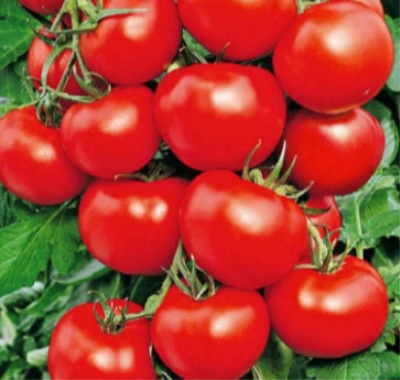
- Authors: Nastenko Natalia Viktorovna, Kachainik Vladimir Georgievich, Gulkin Mikhail Nikolaevich, Agrofirm "Aelita" LLC
- Year of approval: 2013
- Growth type: indeterminate
- Appointment: fresh consumption, for whole fruit preservation
- Ripening period: early
- Ripening time, days: 90-100
- Growing conditions: for open ground, for film greenhouses
- Marketability: high
- Transportability: good
- Bush height, cm: 180
Tomato Moneybag - already, one might say, has left the category of new varieties and moved to the category of ordinary plants. But still, quite a few gardeners do not yet know about this culture. Therefore, a story about her and the features of cultivation will bring considerable benefit.
Breeding history
Developed a Moneybag at Agrofirma Aelita LLC. The breeders Kachainik, Gulkin and Nastenko worked on the project. The result of their joint efforts was reached by the early 2010s. And since 2013, this plant has been available to a wide range of gardeners.
Description of the variety
One of the main features of the Money Bag is that it is an indeterminate variety. Therefore, its bushes up to 1.8 m in height practically do not create any inconvenience even in greenhouse cultivation. Moderately large dark green foliage develops on the branches of such a tomato. The plant is stated to be suitable for open land. It is quite possible to cultivate it in film greenhouses, but in ordinary ones it is hardly possible.
The main qualities of the fruit
When the berries are not yet ripe, they will have a light green color. As the fruit develops fully, it will turn red. The marketability of the crop is quite high. It can be transported over a relatively long distance. The mass of a single copy is 0.08-0.1 kg.
From 12 to 14 fruits will be formed on 1 brush. Their skin is quite dense. The inflorescence is of a simple type. The peduncle is articulated. The keeping quality of the harvest will delight amateurs. Its properties make it possible to resort to whole-fruit canning.
Taste characteristics
The flesh of the Money Bag is firm. Gardeners note its attractive juiciness. A harmonious sourness is mixed with the main sweet taste. The scent is also quite pleasant. Harvested berries are good to use fresh.
Ripening and fruiting
This variety ripens early. Between the sprouting of the seedlings and the readiness of the berries, it takes from 90 to 100 days. It is worth remembering again, however, that weather conditions can make serious adjustments to such a normal schedule. Quite a lot also depends on the efforts of the farmers themselves.
Yield
Collection of fruits per 1 sq. m is 10-11 kg. Until recently, by the standards of tomato culture, it was almost an absolute record. But even today, despite the emergence of a number of attractive competitors, the Money Bag remains in demand. Of course, it will be possible to embody its merits only with the right approach to business.
The timing of planting seedlings and planting in the ground
Seeds are placed in containers (boxes) in the first half of March. If this deadline is met, the approximate time for transplanting into open ground is between May 15 and June 5. But even these periods themselves leave enough room for gardening maneuver. In addition, they can be further modified as required.

Growing tomato seedlings is an extremely important process, because it largely depends on whether the gardener can harvest at all. All aspects must be taken into account, from seedbed preparation to planting in the ground.
Landing scheme
It is advisable to plant such a crop according to the 600x500 mm system. Accommodation is allowed for 1 sq. m 3 or 4 bushes. The choice of one of the options is determined by the preferences of the gardeners. You can take a chance, plant 4 bushes and, with luck, get a larger crop. Or you can choose a careful strategy and limit yourself to 3 plants, simplifying planting care.

Growing and care
To form the bushes of the Money Bag relies on 1 or 2 stems. Without the timely removal of the stepsons, the matter is not complete. Irrigation is best done early in the morning or late in the evening. The best possible option is sprinkling. In this case, it is necessary to avoid, as far as possible, the ingress of water on foliage and stems.
Loosening the soil is critical. Top dressing is carried out 4 or 5 times during the season. First of all, organics are used. Next, you need to focus on the combination of phosphorus and potassium. Good ventilation in greenhouses is highly recommended to draw out moisture and reduce the risk of mold.
Supports are replaced as the bushes grow. The money-bag is also carried out not according to the schedule, but as needed. Weed control is mainly done by weeding. The use of synthetic preparations is justified only in case of strong overgrowth of the beds or special "persistence" of uninvited guests. But even in this case, you must first try the tools at hand.




A plant needs different micronutrients at each stage of growth. All fertilizers can be divided into two groups: mineral and organic. Folk remedies are often used: iodine, yeast, bird droppings, eggshells.
It is important to observe the rate and period of feeding. This also applies to folk remedies and organic fertilizers.


Growing regions
This tomato is really versatile. It can be cultivated in various areas of the Russian Federation:
- from Siberia to the Volga region;
- from the Urals to the Moscow region;
- from the northwest of the European part to the North Caucasus.
Review overview
The evaluations of the Moneybag by farmers are consistently enthusiastic. The juiciness and taste of the fruits pleasantly surprise even advanced breeders. The harvest can be used for harvesting for the winter. You can pick berries early enough. Leaving is relatively uncomplicated.

























































































